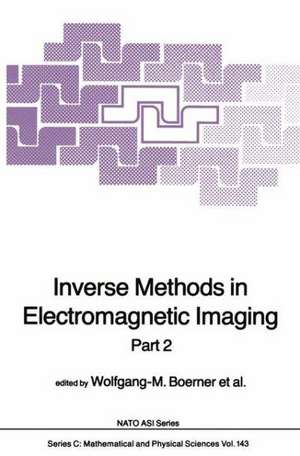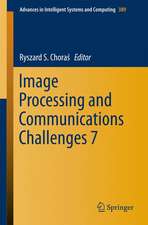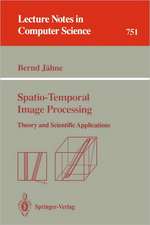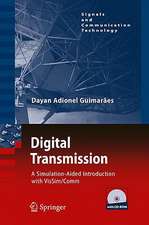Inverse Methods in Electromagnetic Imaging: Part 2: Nato Science Series C:, cartea 143
Autor Wolfgang-M. Boerner, Hans Brand, Leonard A. Cram, Dag T. Gjessing, Arthur K. Jordan, Wolfgang Keydel, Günther Schwierz, Martin Vogelen Limba Engleză Paperback – 20 noi 2013
Din seria Nato Science Series C:
- 24%
 Preț: 797.66 lei
Preț: 797.66 lei - 18%
 Preț: 957.62 lei
Preț: 957.62 lei - 18%
 Preț: 957.13 lei
Preț: 957.13 lei - 18%
 Preț: 1227.52 lei
Preț: 1227.52 lei -
 Preț: 396.40 lei
Preț: 396.40 lei -
 Preț: 403.75 lei
Preț: 403.75 lei - 18%
 Preț: 1239.37 lei
Preț: 1239.37 lei - 18%
 Preț: 1236.51 lei
Preț: 1236.51 lei - 18%
 Preț: 1231.78 lei
Preț: 1231.78 lei - 18%
 Preț: 1229.10 lei
Preț: 1229.10 lei - 18%
 Preț: 1835.21 lei
Preț: 1835.21 lei - 24%
 Preț: 1076.36 lei
Preț: 1076.36 lei -
 Preț: 390.46 lei
Preț: 390.46 lei -
 Preț: 369.63 lei
Preț: 369.63 lei - 18%
 Preț: 1232.41 lei
Preț: 1232.41 lei -
 Preț: 394.51 lei
Preț: 394.51 lei - 18%
 Preț: 1226.24 lei
Preț: 1226.24 lei - 18%
 Preț: 1845.80 lei
Preț: 1845.80 lei -
 Preț: 399.88 lei
Preț: 399.88 lei -
 Preț: 384.28 lei
Preț: 384.28 lei -
 Preț: 390.88 lei
Preț: 390.88 lei -
 Preț: 381.19 lei
Preț: 381.19 lei - 18%
 Preț: 1848.64 lei
Preț: 1848.64 lei - 18%
 Preț: 951.14 lei
Preț: 951.14 lei - 18%
 Preț: 1230.35 lei
Preț: 1230.35 lei - 18%
 Preț: 1236.51 lei
Preț: 1236.51 lei -
 Preț: 401.03 lei
Preț: 401.03 lei -
 Preț: 406.25 lei
Preț: 406.25 lei - 18%
 Preț: 1230.84 lei
Preț: 1230.84 lei -
 Preț: 418.34 lei
Preț: 418.34 lei - 18%
 Preț: 1223.74 lei
Preț: 1223.74 lei
Preț: 410.88 lei
Nou
Puncte Express: 616
Preț estimativ în valută:
78.62€ • 82.53$ • 65.26£
78.62€ • 82.53$ • 65.26£
Carte tipărită la comandă
Livrare economică 10-24 aprilie
Preluare comenzi: 021 569.72.76
Specificații
ISBN-13: 9789401088282
ISBN-10: 9401088284
Pagini: 692
Ilustrații: XII, 1347 p. 170 illus., 3 illus. in color.
Dimensiuni: 155 x 235 x 36 mm
Greutate: 0.95 kg
Ediția:Softcover reprint of the original 1st ed. 1985
Editura: SPRINGER NETHERLANDS
Colecția Springer
Seria Nato Science Series C:
Locul publicării:Dordrecht, Netherlands
ISBN-10: 9401088284
Pagini: 692
Ilustrații: XII, 1347 p. 170 illus., 3 illus. in color.
Dimensiuni: 155 x 235 x 36 mm
Greutate: 0.95 kg
Ediția:Softcover reprint of the original 1st ed. 1985
Editura: SPRINGER NETHERLANDS
Colecția Springer
Seria Nato Science Series C:
Locul publicării:Dordrecht, Netherlands
Public țintă
ResearchCuprins
Table of Contents (Part 2).- TOPIC III (Papers are cross-referenced with the Final Technical Program (Outline. Given are session and sequence of presentation, i.e., OS.3).- III.10 (SR.4) Study of Two Scatterer Interference with a Polarimetric FM/CW Radar.- III.11 (SP.5) Polarization Dependence in Angle Tracking Systems.- III.12 (SS.4) Interpretation of High Resolution Polarimetric Radar Target Down-Range Signatures Using Kennaugh’s and Huynen’s Target Characteristic Operator Theories.- III.13 (MM.5) Demands on Polarization Purity in the Measurement and Imaging of Distributed Clutter.- III.14 (SP.2) Polarization Vector Signal Processing for Radar Clutter Suppression.- Topic IV — Image Quality and Image Resolution in Remote Sensing and Surveillance.- IV.1 (RS.1) The Radiative Transfer Approach in Electromagnetic Imaging.- IV.2 (RP.4) Towards a Theory of Perception for Radar Targets with Application to the Analysis of Their Data Base Structures and Presentations.- IV.3 (SI.4) Radar Imagery.- IV.4 (SI.1) Inverse Methods Applied to Microwave Target Imaging.- IV.5 (SR.1) (SP.4) Optimum Detection Techniques in Relation to Shape and Size of Objects, Motion Pattern and Material Composition.- IV.6 (RS.3) Inverse Methods for Ocean Wave Imaging By Sar.- IV.7 (RS.2) Inverse Methods in Rough-Surface Scattering.- IV.8 (SI.2) On the Optimum Detection of Surface Chemical Compounds.- IV.9 (SI.3) Inversion Problems in Sar Imaging.- IV.10 (SI.5) Inverse Methods in Radio Glaciology.- IV.11 (MI.1) Fast Millimeter Wave Imaging.- IV.12 (IM.2) Electromagnetic Low Frequency Imaging.- IV.13 (MI.5) Electromagnetic Imaging of Dielectric Targets.- IV.14 (MI.3) A Four-Channel Millimeter-Wave On-Line Imaging Method.- TOPIC V — Holographic and Tomographic Imaging and Related Phase Problems.-V.1 (0I.1) The Holographic Principle.- V.2 (PT.1) Review of Tomographic Imaging Methods Applied to Medical Imaging.- V.3 (MM.1) Inverse Methods in Microwave Metrology.- V.4 (MI.2) Holographic & Tomographic Imaging with Microwaves and Ultrasound.- V.5 (PT.4) Diffraction Tomography.- V.6 (PT.3) Algorithms and Error Analysis for Diffraction Tomo-Graphy Using the Born and Rytov Approximations.- V.7 (PT.5) Extension of Scalar to Vector Propagation Tomography — A Computer Numerical Approach.- V.8 (OI.4) Image Processing: Analysis Beyond Matched Filtering.- V.9 (OI.3) Modifications of the Gerchberg Method Applied to Electromagnetic Imaging.- V.10 (MI.4) Phase Comparison Monopulse Side Scan Radar.- V.11 (MM.4) Diagnostic Measurements and Analysis of Wave Mechanisms in Radomes.- V.12 (OI.2) Synthesis & Detection of Electromagnetic Authenticity Features.- V.13 (SR.5) Improvement of Image Fidelity in Microwave Imaging Through Diversity Techniques.- V.14 (SP.6*) Far-Field to Near-Field Transforms in Spherical Coordinates.- TOPIC VI — Working Discussion Group Reports.- VI Final Reports of Working Discussion Groups Background.- VI.1 Mathematical Inversion Methods and Transient Techniques (W-A).- VI.2 Numerical Instabilities in Electromagnetic Inverse Problems (W-B).- VI.3 Polarization Utilization in High Resolution Imaging (W-C).- VI.4 Definition of Image Quality and Image Resolution in Remote Sensing and Surveillance (W-D).- VI.5 Holographic and Tomographic Imaging and Related Phase Problems (W-E).- VI.6 Enhancement of Interaction Between Active R&DLabs within Nato-Member Countries on the Subject of Electromagnetic Imaging (W-F).- VI.7 Overall Final Report.- Final Technical Program Outline.- Keyword Index.- Author Index.- List of Invitees.

























